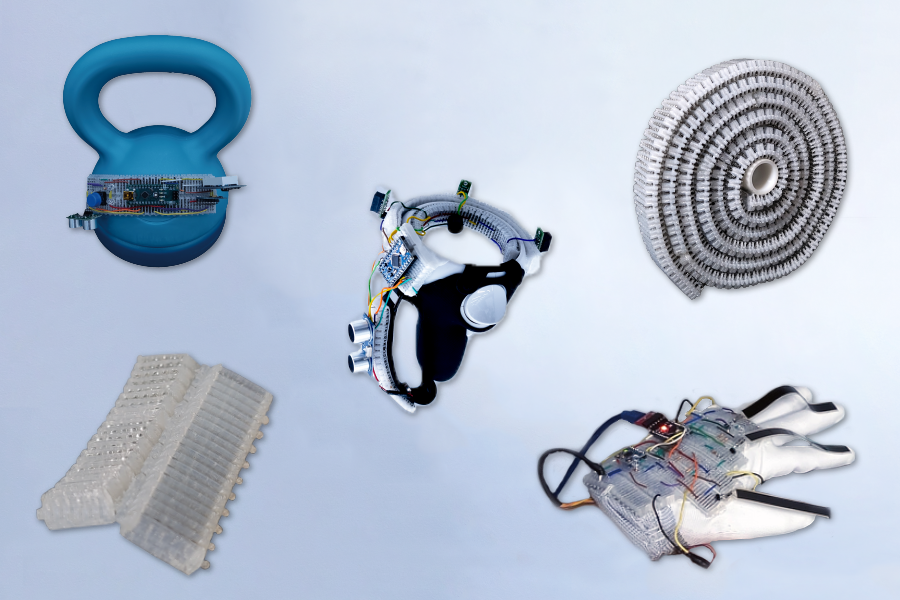
FlexBoard is a flexible breadboard that enables rapid prototyping of objects with interactive sensors, actuators, and displays on curved and deformable surfaces.
Alex Shipps | MIT CSAIL
Whether you are a new employee, a gymnast, or a bendy straw manufacturer, one trait is ideal across the board: flexibility.
The same can now be said about prototyping electronic devices. While designers typically test out their designs on “breadboards,” or thin plastic boards that can hold together electronic components, they are often stiff and slow. With the rigidity of these electronic backbones in mind, MIT researchers developed “FlexBoard,” a flexible breadboard that enables rapid prototyping of objects with interactive sensors, actuators, and displays on curved and deformable surfaces, such as a ball or clothes.
To illustrate the platform’s versatility on different items, researchers tested it out on kettlebells, video game controllers, and gloves, finding that sensors and displays can attach to the electronic components within each of its hinges. The team added sensors and LEDs to the kettlebells, which successfully detected whether users were applying the correct form to their swing workouts. In turn, the display indicated red if done incorrectly, or green if executed properly, as well as the number of repetitions. In the future, the platform could improve fitness routines by providing that feedback.
The breadboard’s design consists of a thin plastic that connects two pieces of the same material to enhance flexibility. This “living hinge pattern” can be found in the caps of condiment bottles and the spines of plastic disc cases, holding together FlexBoard’s electronic components. The design can be replicated by an off-the-shelf 3D printer, fabricating FlexBoards that can be sewn to an item or attached using epoxy glue or Velcro tape.
This convenient design opens the door to more rapidly customizable interfaces. “A fundamental development in our modern world is that we can interact with digital content everywhere and anytime, which is enabled through ubiquitous interactive devices,” says research author Michael Wessely, a recent postdoc at the MIT Computer Science and Artificial Intelligence Laboratory (CSAIL) who is now an assistant professor at Aarhus University. “FlexBoard supports the design of these devices by being a versatile and rapid interaction prototyping platform. Our platform also enables designers to quickly test different configurations of sensors, displays, and other interactive components, which might lead to faster product development cycles and more user-friendly and accessible designs.”
FlexBoard can also enhance virtual reality gaming through controllers and gloves. The team installed a collision warning system on the controllers, alerting players wearing a VR headset when they risk bumping into their surroundings. Sensors and motors were added to deformable gloves to capture gestures, influencing players’ in-game interactions.
Each breadboard is reusable and adhesive, meaning it can withstand repeated bending in both upward and downward directions while remaining fully attached to the prototypes they were tested on. Wessely and the team evaluated FlexBoard’s durability by bending it 1,000 times, noting that the breadboards remained fully functional without breaking afterward. This bidirectional flexibility helps the platform attach to items with curved designs, making FlexBoard a convenient prototyping platform for makers experimenting with different hardware to create new electronic items.
Users can cut the long breadboard strips into smaller segments for tinier items, or several can be attached to prototype on larger objects. For example, several FlexBoards could be wrapped around a tennis racquet, expanding the sensors’ range of detection when reading the speed of a volley.
The platform’s adaptability to different surfaces can streamline the electronic prototyping process. “While designing new interactive devices, user interfaces, or most electronic products, we usually treat the object form and electronic functions as two separate tasks, which makes it hard to test the prototype in its use environment in the early stage, and can lead to integration issues further down the road,” adds Junyi Zhu, MIT PhD student in electrical engineering and computer science and CSAIL affiliate. “FlexBoards tackle these issues with enhanced, reusable flexible breadboards, which accelerate the current interactive device prototyping pipeline, and provide a new and valuable prototyping platform for the low-power electronics design and DIY [do-it-yourself] community.”
In the future, FlexBoard could make workout equipment, kitchen tools, furniture, and other household items more interactive. Still, the team acknowledges that their platform needs to be further optimized, requiring improved bendability, durability, and strength through multi-material printing. Additionally, each breadboard is designed for FDM printers, an off-the-shelf 3D fabrication machine, which limits the length and increases the print time of FlexBoards. The terminal strips also require manual assembly and make prototyping bendable objects challenging.
“As many researchers have investigated diversifying material properties, we questioned why the breadboard remains rigid,” says Donghyeon Ko, another author of the work who is a former MIT visiting PhD student from the Korea Advanced Institute of Science and Technology. “We wanted to make everyday objects ‘breadboard-able’ while developing shape-changing interfaces.”
Wessely, Zhu, and Ko wrote a paper on the work alongside Stefanie Mueller, a CSAIL affiliate and associate professor in the MIT departments of Electrical Engineering and Computer Science and Mechanical Engineering, and Yoonji Kim, an assistant professor in the College of Art and Technology at Chung-Ang University. The team’s research was supported by the National Research Foundation of Korea (NRF) grant funded by the Korean government, the Ministry of Education of the Republic of Korea, and the National Research Foundation of Korea.
FlexBoard was presented at the 2023 CHI Conference on Human Factors in Computing Systems in April.
